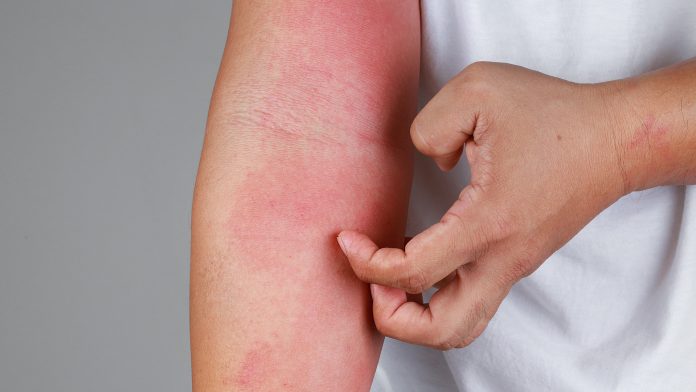
A study from the University of Bonn has identified a skin inflammation signalling pathway that can combat UV damage and skin infections.
Inflammatory skin reactions can help to reduce damage from UV radiation and infections but can also cause painful symptoms similar to sunburn. A recent study from the University of Bonn has found a molecular control which integrates these stress signals.
The results have been published in the Journal of Experimental Medicine.
Skin inflammation is an essential defence mechanism
Skin is the largest organ in the human body, providing a barrier against environmental stimuli and pathogens. Painful skin inflammation can occur if this barrier is infiltrated, as is seen after sunburn. The mechanism of how such skin inflammation is triggered has not been fully understood prior to this research.
“In our study, we took a closer look at the processes involved,” said Professor Dr Florian Schmidt, who led the research group at the Institute of Innate Immunity at the University Hospital Bonn.
When UV light hits the skin, it can damage important cellular molecules due to the high energy contained within it. Skin inflammation is a common consequence of this damage.
“We have now been able to show that a known cellular stress signalling pathway can trigger these inflammatory responses,” explained Dr Schmidt.
Ribosomes in the skin cells assemble proteins based on instructions contained within the cell’s genetic material. When this process is impaired due to UV damage, the cells sound an alarm. Triggering the ribotoxic stress response. It has previously been established that this causes a signalling cascade resulting in the activation of the enzyme p38.
“Our research shows that p38 molecularly modifies NLRP1, a critical switch for inflammation in the skin, and thus activates it in a novel way. This initiates the assembly of inflammasomes from many molecular building blocks,” said Dr Schmidt.
Inflammasomes are highly important in the innate immune system. This complex molecular machine can convert inactive messenger substances for inflammation into their active form. They also ensure that numerous holes are formed in the cell membrane allowing the messenger substances to reach the outside and activate the body’s defence system.
These holes cause the cells to die. The cells essentially explode and empty their contents into the tissue. The molecules are released from within the cell, which acts as another warning sign for the immune system.
Viruses can also activate the signalling pathway
The researchers also discovered that the p38 enzyme is not only activated by UV light.
“We were able to show that mosquito-borne viruses can activate NLRP1 through p38 as well,” explained Lea-Marie Jenster, a PhD student in the Schmidt lab and the lead author of this study.
“These include, for instance, the chikungunya virus, which is a major problem in parts of Africa and Asia and could also reach Germany in the wake of climate change.”
This led the researchers to hypothesise that certain viruses may even trigger the activation of p38 via several different pathways.
“P38 is a molecular information hub in the skin, in which various warning signals converge – similar to the fire department’s control centre. However, not every incoming call for help immediately triggers the assembly of inflammasomes – this only happens when the number and intensity of alerts exceed a certain threshold,” Schmidt explained.
This regulation is vital, as inflammasomes can be dangerous and can cause considerable collateral damage. A strong skin inflammation that is triggered by inflammasomes can cause parts of the skin tissue to perish. The findings have encouraged researchers to explore the possibility of using the p38 enzyme to specifically suppress harmful immune reactions in the skin.
























